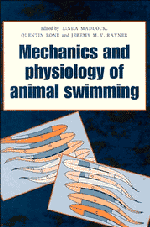Book contents
- Frontmatter
- Contents
- Contributors
- Introduction
- 1 Functional patterns of swimming bacteria
- 2 Buoyancy and swimming in marine planktonic protists
- 3 The role of fins in the competition between squid and fish
- 4 The biology of fish swimming
- 5 Swimming physiology of pelagic fishes
- 6 The mechanical design of the fish muscular system
- 7 How do fish use their myotomal muscle to swim? In vitro simulations of in vivo activity patterns
- 8 The timing of lateral muscle strain and EMG activity in different species of steadily swimming fish
- 9 Swimming in the lamprey: modelling the neural pattern generation, the body dynamics and the fluid mechanics
- 10 Swimming capabilities of Mesozoic marine reptiles: a review
- 11 Stone, bone or blubber? Buoyancy control strategies in aquatic tetrapods
- 12 Functional anatomy of the ‘flight’ apparatus in penguins
- 13 Energy conservation by formation swimming: metabolic evidence from ducklings
- Bibliography
- Index
13 - Energy conservation by formation swimming: metabolic evidence from ducklings
Published online by Cambridge University Press: 05 March 2012
- Frontmatter
- Contents
- Contributors
- Introduction
- 1 Functional patterns of swimming bacteria
- 2 Buoyancy and swimming in marine planktonic protists
- 3 The role of fins in the competition between squid and fish
- 4 The biology of fish swimming
- 5 Swimming physiology of pelagic fishes
- 6 The mechanical design of the fish muscular system
- 7 How do fish use their myotomal muscle to swim? In vitro simulations of in vivo activity patterns
- 8 The timing of lateral muscle strain and EMG activity in different species of steadily swimming fish
- 9 Swimming in the lamprey: modelling the neural pattern generation, the body dynamics and the fluid mechanics
- 10 Swimming capabilities of Mesozoic marine reptiles: a review
- 11 Stone, bone or blubber? Buoyancy control strategies in aquatic tetrapods
- 12 Functional anatomy of the ‘flight’ apparatus in penguins
- 13 Energy conservation by formation swimming: metabolic evidence from ducklings
- Bibliography
- Index
Summary
Formation movement, particularly during swimming and flying, has been hypothesized to reduce an individual animal's energy expenditure. Although a number of aeroand hydrodynamic models have been proposed to estimate energy savings of animals travelling in formation, little empirical data are available that test this presumption. An examination of the metabolic energetics of formation swimming was undertaken with mallard ducklings (Anas platyrhynchos) trained to swim behind a decoy in a flow tank. Oxygen consumption was measured for ducklings in clutches of one, two or four individuals, with the decoy in the water or suspended above the surface. Metabolic rate per individual duckling decreased with increasing clutch size by 7·8-43·5%. Following in the wake of a decoy significantly decreased metabolic swimming effort by ducklings and this effect was most pronounced at three days of age and in small clutches. These findings suggest that the flow pattern generated by the formation and in the wake of an adult reduces the resistance of the water to locomotion and allows an individual duckling to conserve energy.
INTRODUCTION
Locomotion is an energetically costly activity that may comprise a significant component of an animal's overall energy budget (Weihs & Webb, 1983; Fish, 1992). Therefore it is advantageous for animals to use locomotor strategies which minimize energetic expenditure. Such strategies include gait transition, intermittent locomotion, soaring, tidal stream transport, wave riding, submerged swimming, porpoising and formation movement (Cone, 1962; Lissaman & Schollenberger, 1970; Pennycuick, 1972; Weihs, 1973, 1974, 1978; Au & Weihs, 1980; Hoyt & Taylor, 1981; Williams, 1989; Fish et al., 1991; Williams et al., 1992).
- Type
- Chapter
- Information
- The Mechanics and Physiology of Animal Swimming , pp. 193 - 204Publisher: Cambridge University PressPrint publication year: 1994
- 14
- Cited by



